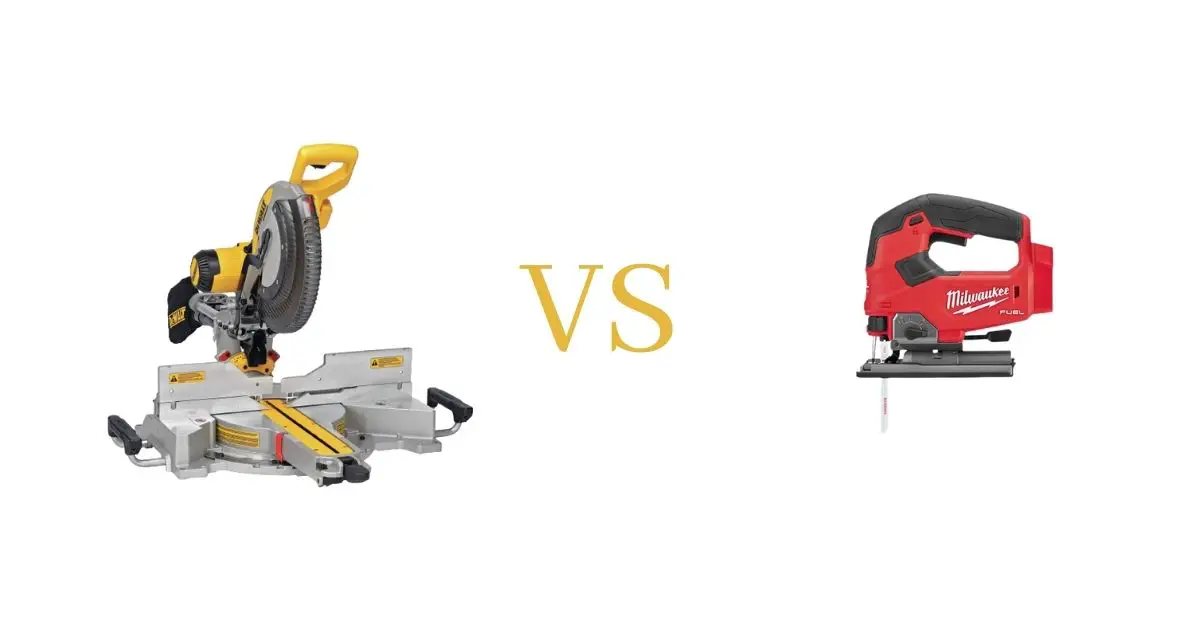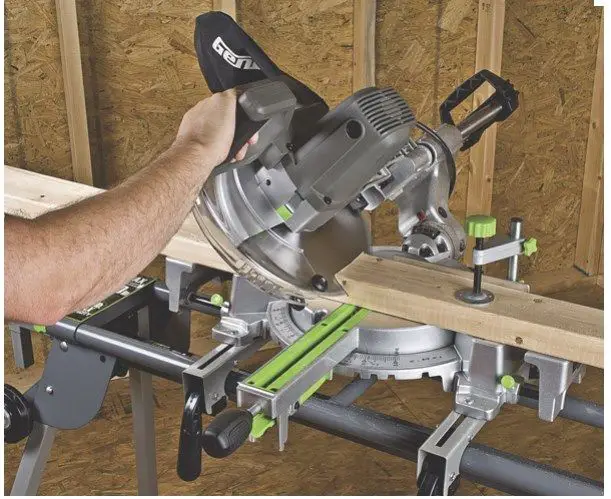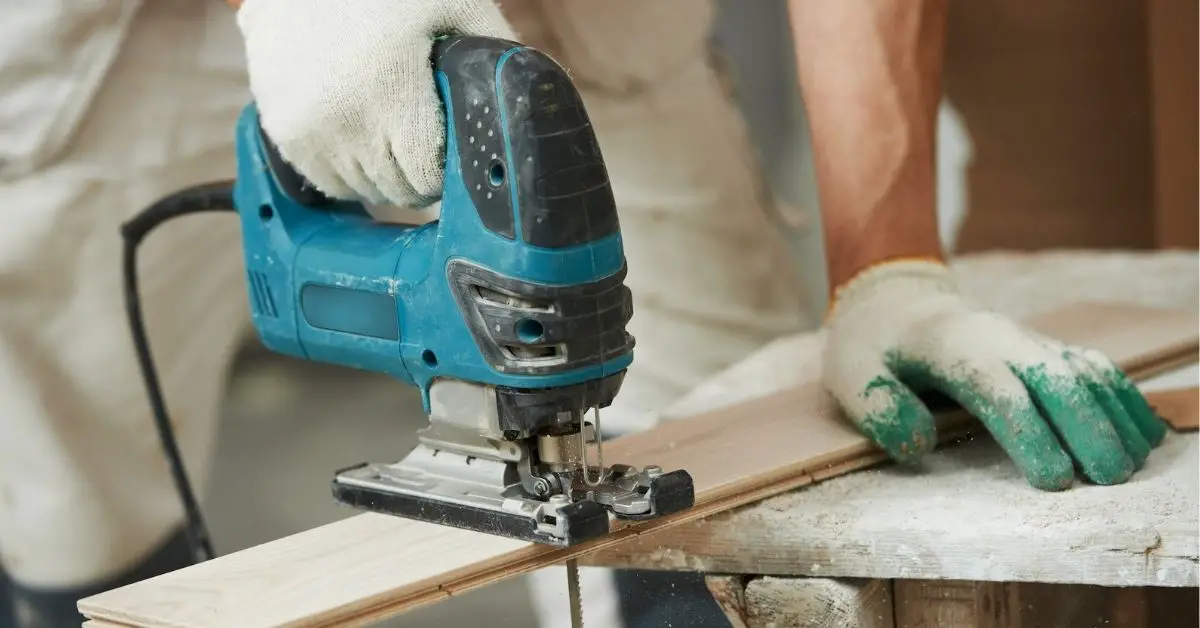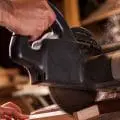Power Tools
Miter Saw vs Jigsaw
Both the miter saw and the jigsaw are woodshop staples. Without either of these tools, some areas of your work will suffer inescapable handicaps. The miter saw vs. jigsaw conversation tells us that both tools are good at making some cuts, but neither can do it all.
Miter saws are excellent for making straight cuts, whether you need them at an angle or beveled to create joints. Jigsaws don’t come with the cutting accuracy and efficiency of miter saws, but they’re the best tools for cutting notches, curves, and non-straight lines. That’s the most significant difference between the two types of saws.
When should you use a miter saw, and when is a jigsaw the best tool for the job?
When To Use a Miter Saw
When you need straight cuts
One thing a miter saw is good at is making inch-perfect straight cuts. That’s what the fence is for—to guide the blade with unrivaled precision. Jigsaws can cut straight too, but it’s pretty challenging to stay on the designated cut line without built-in guiding mechanisms.
When you need angled cuts
The base of a miter saw can rotate from the default 90-degree angle to allow you to make cuts at 45 degrees and even 60 degrees. Again, it does so with unmatched precision, which is why you’re better off using it over a jigsaw when creating joints or taking on projects that need angled cuts.
When you need beveled cuts
Miter saws are unique cutting tools because the blade can lean 45 degrees to the left or right to make a beveled cut. This is yet another vital type of cut for projects like door frames and moldings.
When you need compound cuts
A compound cut is a mix between an angled miter cut and a bevel cut. Only miter saws can make such cuts, which is why they’re the go-to power saw for most types of straight cuts, whether an angle is needed or not.
When to Use a Jigsaw
When you need curved cuts
Jigsaws are the experts at making non-straight cuts. When you need to cut irregular lines, perhaps to fit specific designs, a jigsaw will give you much more freedom than a miter saw. Besides, it can be dangerous and time-consuming to try and cut curves using a miter saw—something you shouldn’t try for your safety.
When you need to cut notches
Do you want to make a hole or a notch in a solid board? A jigsaw is a right tool for the job. A miter saw’s blade can only be cut from the edges of the workpiece, but with a jigsaw, you can cut from the center or the edge depending on the needs of your project.
When you need to make detailed cuts
Think of a jigsaw as a paper scalpel. It’s easy to maneuver, and it can create highly detailed designs on any part of the workpiece. On the other hand, miter saws are like scissors. Sure, you can get some degree of the curve if you want to, but it’s primarily suited for making straight cuts. Also, paper scalpels can be cut from any side of the paper, whereas scissors need to begin at the edges.
Why a Miter Saw is Better for Beginners
Miter saws are safer.
Miter saws are infinitely much safer to use than handheld jigsaws. We attribute much of that to the fences, which keep the workpiece in place, preventing it from slipping and sustaining damage or causing harm. Miter saws also have brakes, which means you can bring them to a quick stop if you need to.
Miter saws have better dust collection.
Most jigsaws won’t collect dust without suction. That means buying a shop vac separately. Conversely, many miter saws come with built-in vacuums that make the dust collection process quicker. Shop vacs are effective, but they’re also very loud.
Miter saws are easier to use
Most of them have oversized bevel detents, easy depth adjustment, and several redundant cutting and measuring features to make your work as easy and as safe as possible, even if you’re not a seasoned carpenter.
The Best Miter Saws for Beginners
Metabo HPT Compound Miter Saw
For a first-time buyer, the Metabo C10FGS is the perfect miter saw. It’s got a 15-amp motor with a no-load top speed of 5,000 RPM, a large table, a 0 – 52-degree miter angle range, and a 0 – 45-degree bevel range. It only weighs 24.2 pounds to boot. These are great specs for a tool that’s under $150.
As a beginner, you’ll have much better support for materials on a table. The Metabo C10FGS gives you a clamping system too so that you can secure your workpiece. It features the standard horizontal handle, which is the best option for ease of use. Adjusting the miter is relatively straightforward. Thanks to its beginner-friendly design, all you need is your thumb when adjusting the miter angle.
The Metabo C10FGS also leans to the left to give you bevel cuts from 0 – 45 degrees. It comes with 10-inch tungsten carbide-tipped (TCT) blades, a 5mm hexagonal bar wrench, and a dust bag.
DeWalt DWS715 Single Bevel Compound Miter Saw
DeWalt’s DWS715 is an adequate entry-level miter saw, one that equips you with most of the basic features you’ll need to make straight, beveled, and miter cuts. Its 15-amp motor gives you a maximum of 4,000 RPM, and with a precise miter system and a fence that supports machined bases, you can tinker with different bases once you get comfortable using the tool.
It has a tall sliding fence that can hold a 5 ½-inch base vertically, and it bevels to the left (0 – 48 degrees) and to the right (0 – 3 degrees) to give you more cutting options when making beveled ends. The 12-inch miter saw can make 2 x 8-inch cuts across dimensional lumber at 90 degrees and 2 x 6-inch cuts at 45 degrees. It’s only 15 inches tall, so it’s very maneuverable.
At 41.6 pounds, it is light enough to handle, and since it comes with carbide-tipped blades, you can rest assured of its cutting accuracy and durability. Aside from the tool, you also get a TCT blade, a wrench, a dust bag, and a vertical clamp.
Why You Should Trust Us
At Woodworking Tool Guide, we know one size doesn't fit all! We cater to every woodworker, from beginner to pro, with insights and recommendations tailored to your skill level, project needs, and budget. We take the guesswork out of choosing the right tools, whether you're tackling your first crafting a masterpiece for the ages. So grab your chisel, join our community, and let's build something amazing together!
Woodworking Tool Guide wasn't just born, it sprouted from a seed of passion for the craft. What started as a joyful exploration blossomed into a trusted online haven for fellow enthusiasts like you. We pour our love into meticulously chosen review selections, meticulous hands-on testing, and lab-backed insights, all to empower you with reliable, comprehensive information you can build on. So, grab your tools, trust our guidance, and let's build something beautiful together!
Passion-Driven Expertise
Our journey started with a shared love for woodworking. The team behind the Woodworking Tool Guide is comprised of individuals who are not just writers but passionate woodworkers themselves. This shared enthusiasm ensures that our content is crafted with a deep understanding of the craft and an authentic appreciation for quality tools.
Top Tool Guides Online
Woodworking Tool Guide has rapidly ascended to become one of the premier online destinations for tool guidance. Our commitment to excellence and the accuracy of our information has positioned us as a reliable source for both beginners and seasoned woodworkers seeking trustworthy advice on the best tools for their projects.
User-Centric Approach
Our content caters to every woodworker, from rookies just starting out to seasoned pros tackling intricate projects. We tailor our insights and recommendations to your skill level, project needs, and budget, ensuring you find the perfect tools to match your unique woodworking journey. So step into your workshop, grab your tool belt, and let Woodworking Tool Guide be your trusted companion as you craft your masterpieces.
Continuous Support and Innovation
Woodworking is an ever-evolving craft, and so is our commitment to supporting you. We are dedicated to bringing you the latest information on woodworking tools, techniques, and trends. Our team is actively working to expand our content and bring you more valuable insights, ensuring that you stay well-informed in your woodworking adventure.
Hands-On Experience
Ditch the endless research rabbit hole! At Woodworking Tool Guide, we believe in actionable advice, not armchair analysis. We get our hands dirty, putting every tool through its paces in real-world woodworking scenarios. Whether it's the precision of a table saw, the versatility of a router, or the tactile satisfaction of a handplane, we test for performance, durability, and user-friendliness. No more sifting through dry specs – we deliver practical insights you can trust to transform your woodworking dreams into reality.
Woodworking Tool Guide isn't just a review site, it's your trusted companion on the sawdust-filled path to woodworking mastery. Our expert team, led by veteran David Jones, meticulously tests and explains tools in terms you understand. We cut through the jargon, bias, and confusion with real-world insights and honest evaluations. Join our passionate community, where decades of experience, cutting-edge knowledge, and shared love for the craft come together to guide you every step of the way. So grab your chisel, buckle up, and let's embark on this exciting woodworking adventure, together!









